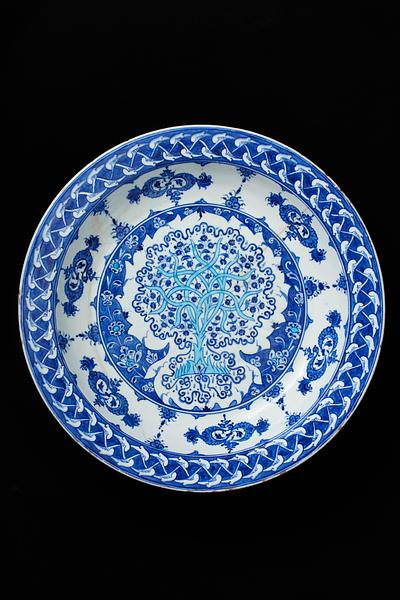Fritware dish, painted in blue and turquoise under a transparent glaze
Turkey, Iznik; c. 1530-1535
Diam: 35.5; H: 6.5 cm
The dish belongs to a small group of ceramics made in what is called the
Potter’s Style.
[1] The group was characterized by stylistic innovations and the use of turquoise as well as a return to older blue-and-white Iznik pottery in the
Baba Nakkas style (see e.g.
93a/2003). In this piece, this is first and foremost true of the rim’s intertwined palmette frieze, the cavetto’s six Chinese-inspired cloud ornaments, and the well’s outermost branches with flowers of different kinds.
The central motif is a tree with serpent-like branches from which a wealth of twigs emerge with little leaves and flowers not unlike the ones found in the period’s
tughrakes style (see
11/1970). The tree is surrounded by an unusual, wavy contour in blue nuances that in turn is framed by a white, flaming aura that endows the entire dish with an emotional or spiritual expression. Only three dishes with a related theme are known from the period, and it should perhaps be seen in relation to the ancient and broadly interpretable motif “The Tree of Life,” which also plays a role in Sufism as the way to heaven or more profound understanding.
Inv. no. 18/2017
Published in:
Hotel Drout, Paris, 16-17/5-1902, lot 115;
Bernard Rackham: Islamic pottery and Italian maiolica: illustrated catalogue of a private collection, London 1959, cat.no. 61, pl. 26;
Nurhan Atasoy and Julian Raby: Iznik: the pottery of Ottoman Turkey, London 1989, p. 117, fig. 168;
Sotheby’s, London, 19/10-2016, lot 295;
Christie’s, London, 27/4-2017, lot 156;


.jpg?locale=en)